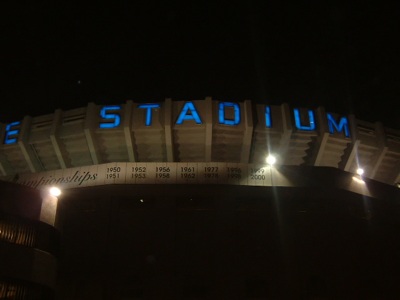
Opened: April 18, 1923
First Regular Season Game:
April 18, 1923 (4-1 victory over the Boston Red Sox)
Construction Began: May 5, 1922
Capacity: 57,478
Original Construction Cost: $2,500,000
Stadium Design: Jewel Box
Information from Wikipedia
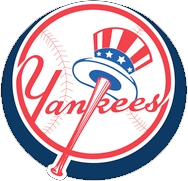

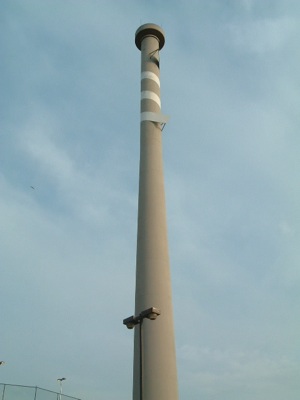 Babe Ruth was making a name for himself by setting both homerun and pitching records, and he also brought the Boston Red Sox two World Series victories during his 5-year tenure in Beantown. Those World Series championships included the Sox last World Series victory of the 20th century in 1918. The 1919 season, however, saw the Red Sox sitting in 6th place in the American League with a disappointing 66-71 record even as Babe Ruth was smacking 29 homeruns to set a new major league record. The Red Sox were sold after the 1919 season to Harry Frazee, and in December of that year he sold the budding superstar Ruth to the New York Yankees for $125,000 in cash as well as a $350,000 loan intended to fund Frazee's passion for Broadway production. This would become one of the most lopsided deals in sports, and help fuel one of baseball's most bitter rivalries.
Babe Ruth was making a name for himself by setting both homerun and pitching records, and he also brought the Boston Red Sox two World Series victories during his 5-year tenure in Beantown. Those World Series championships included the Sox last World Series victory of the 20th century in 1918. The 1919 season, however, saw the Red Sox sitting in 6th place in the American League with a disappointing 66-71 record even as Babe Ruth was smacking 29 homeruns to set a new major league record. The Red Sox were sold after the 1919 season to Harry Frazee, and in December of that year he sold the budding superstar Ruth to the New York Yankees for $125,000 in cash as well as a $350,000 loan intended to fund Frazee's passion for Broadway production. This would become one of the most lopsided deals in sports, and help fuel one of baseball's most bitter rivalries.
Babe Ruth made an immediate impact for the Yankees in his new role as a full-time outfielder, and he would continue to slug homers at a record-setting pace. His slugging did much to improve the Yankees' home game attendance as they became the first professional baseball team to draw more than one million fans in a single season. They did this to the consternation of their current ballpark's tenants, the New York Giants. The Giants were annoyed that the Yankees were outdrawing them in their own park, the Polo Grounds, so they notified the Yankees that they must find a new home field as soon as possible.
On February 6, 1921 the Yankees announced the purchase of ten acres of property belonging to the estate of famous capitalist and author William Waldorf Astor. The land was situated in the west Bronx directly across the Harlem River from the Yankees' current home in the Manhattan Polo Grounds, and cost the team $675,000. The owners wanted the new field to be a behemoth capable of holding 70,000 screaming fans, and it was already determined that the park would be the first ballpark to be referred to as a "stadium." The exact look of the park, though, had yet to be finalized. An early design had the stadium triple-decked with a roof totally covering the seats so that only passing airplanes could catch a glimpse inside. The grand structure would feature towering embattlements, and would be a marvel of modern architecture. This bold scheme was scaled back, however, and, to the chagrin of the Yankees' owners, the field could actually be seen from the passing elevated train as well as from buildings located across the street. One of the few elements that did survive from the initial draft was a scalloped frieze that would cap the roof of the first triple-decker grandstand in baseball, and it would become a well-known feature of the Stadium.
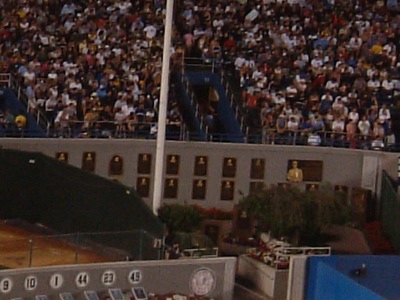 On April 18, 1923 Yankee Stadium opened its doors to 60,000 baseball fans. Although a higher number of 74,200 was exaggeratedly reported to be at the game it is clear that many thousands of fans had to be turned away after the game was sold out. Those who did have the privilege of seeing the game saw Babe Ruth hit the first homerun in the Stadium; a shot that was described by The New York Times as "the real baptism of Yankee Stadium." Yankee Stadium truly was the "House That Ruth Built," and a few months after the Stadium opened its doors the Yankees won their first World Series title by defeating the rival New York Giants in six games.
On April 18, 1923 Yankee Stadium opened its doors to 60,000 baseball fans. Although a higher number of 74,200 was exaggeratedly reported to be at the game it is clear that many thousands of fans had to be turned away after the game was sold out. Those who did have the privilege of seeing the game saw Babe Ruth hit the first homerun in the Stadium; a shot that was described by The New York Times as "the real baptism of Yankee Stadium." Yankee Stadium truly was the "House That Ruth Built," and a few months after the Stadium opened its doors the Yankees won their first World Series title by defeating the rival New York Giants in six games.
The new stadium greatly favored left-handed hitters as the right-field foul pole was a mere 295 feet from home plate. However, Yankee Stadium was far from a hitter's ballpark for the righties with the left-field pole 395 feet from the plate, and left-center a staggering 460 feet away. Left-center field became known as Death Valley for hitters, and the term "Death Valley" would be generically used for the outfield areas of baseball parks where it was difficult to hit a homerun. Monuments to past Yankee greats were placed deep in Death Valley. The first monument honoring manager Miller Huggins was unveiled in 1932, and Lou Gehrig and Babe Ruth followed with plaques in 1941 and 1949, respectively. Another monument was dedicated for Joe DiMaggio in 1999, and other plaques celebrate Yankee greats such as Yogi Berra, Whitey Ford, Lefty Gomez, Roger Maris, Mickey Mantle, Don Mattingly, Phil Rizzuto, and Casey Stengel.
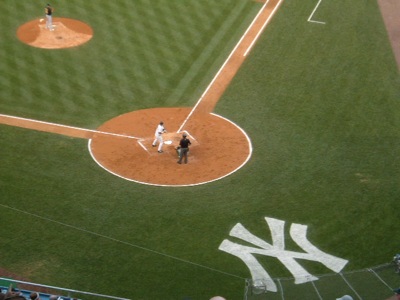 A great amount of history could been seen at Yankee Stadium even before the Stadium's reconstruction in the mid-70s. Record-breaking homeruns were seen often at the Stadium. Babe Ruth hit his 60th homerun in front of Yankee fans in 1927, and Roger Maris hit his record-breaking 61st homerun on the same field in 1961. In 1939 Lou Gehrig gave an emotional good-bye speech to the hometown crowd on the 4th of July after it was determined he had ALS, or what would later be known as Lou Gehrig's Disease. On May 15, 1941 Joe DiMaggio hit an RBI single off White Sox pitcher Eddie Smith at the Stadium that would begin his amazing 56-game hitting streak. In 1946 the Yankees became the first team to draw over two million fans in attendance in one season even though they ultimately fell short of making the postseason. Finally, in the 1956 World Series Don Larsen pitched the only perfect game ever in World Series history when he blanked the Brooklyn Dodgers in Game 5. The only time Larsen threw more than two pitches out of the zone was when he reached a third ball against Pee Wee Reese in the first inning. After that the 64,000 fans in attendance got to witness one of the most dominating performances in World Series history. After the Yankee's 50th anniversary in the Stadium in 1973 the Yankees had played in 29 World Series, and they had won 20 titles from those trips.
A great amount of history could been seen at Yankee Stadium even before the Stadium's reconstruction in the mid-70s. Record-breaking homeruns were seen often at the Stadium. Babe Ruth hit his 60th homerun in front of Yankee fans in 1927, and Roger Maris hit his record-breaking 61st homerun on the same field in 1961. In 1939 Lou Gehrig gave an emotional good-bye speech to the hometown crowd on the 4th of July after it was determined he had ALS, or what would later be known as Lou Gehrig's Disease. On May 15, 1941 Joe DiMaggio hit an RBI single off White Sox pitcher Eddie Smith at the Stadium that would begin his amazing 56-game hitting streak. In 1946 the Yankees became the first team to draw over two million fans in attendance in one season even though they ultimately fell short of making the postseason. Finally, in the 1956 World Series Don Larsen pitched the only perfect game ever in World Series history when he blanked the Brooklyn Dodgers in Game 5. The only time Larsen threw more than two pitches out of the zone was when he reached a third ball against Pee Wee Reese in the first inning. After that the 64,000 fans in attendance got to witness one of the most dominating performances in World Series history. After the Yankee's 50th anniversary in the Stadium in 1973 the Yankees had played in 29 World Series, and they had won 20 titles from those trips.
During the first 50 years of Yankee Stadium the only major changes to the park were the addition of lights in 1946 and a major paint-job in 1966, but in the 70s the park really began to show its age. After years of debate the Yankees signed a 30-year lease with the City of New York in 1972 that called for the Stadium to be completely modernized in time for the 1976 season. After the 1973 season the Yankees moved to Shea Stadium for the next two seasons while a major reconstruction effort took place.
The Stadium was completely demolished following the 1973 season, and a major effort began to make Yankee Stadium the most modern home park in baseball. The steel support columns from the old stadium were done away with and replaced by horizontal support brackets underneath the upper decks that made for better sight lines for the fans. This new design, however, did away with the famous scalloped facade that topped the original Yankee Stadium roof. This problem was resolved with an exact replica of the facade being created to fit atop the new 560-foot-long scoreboard that stretched behind the bleachers in the outfield. The new scoreboard featured the first telescreen in baseball, and could display an amazing nine shades of gray. The revamped Yankee Stadium opened on April 15, 1976 in a game the Yankees won against Minnesota 11-4. The Yankees made the World Series in their first year at the new stadium, and overall the Yankees would make the World Series 10 times in the new stadium, winning it 6 times. The Yankees continued success would lead to terms such as "Damn Yankees" and "The Evil Empire," but the favorite term of Yankees fans is the nickname of the Stadium, "The Home of Champions."
"To be a Yankee is a thought in everyone's head...Just walking into Yankee Stadium, chills run through you. I believe there was a higher offer, but no matter how much money is offered, if you want to be a Yankee, you don't think about it."
- Pitcher Jim "Catfish" Hunter, after his signing with the Yankees in 1974
"My office is at Yankee Stadium. Yes, dreams do come true."
-Yankee shortstop Derek Jeter
"In the building I live in on Park Avenue there are ten people who could buy the Yankees, but none of them could hit the ball out of Yankee Stadium."
- "Mr. October," Reggie Jackson
"To play 18 years in Yankee Stadium is the best thing that could ever happen to a ballplayer."
- Yankee great Mickey Mantle
"It's when the Yankees score eight runs in the first inning, and then slowly pull away."
- Yankee owner Jacob Ruppert describing the perfect afternoon at Yankee Stadium in the 1920s
"Going to a Yankee game for the first time is like waking up in a Brazilian jail."
- Anonymous American League Umpire
"Astrodome? You can't grow good hot dogs indoors. Yankee Stadium, September. Hot dogs have been boiling since the opening day in April. That's a hot dog."
- Roy Scheider as Dr. Heywood Floyd in the movie "2010: The Year We Make Contact"
"It gets late early out there."
- Yankee catcher and outfielder Yogi Berra referring to the shadows in left-field at Yankee Stadium
"I'd give a year of my life if I could hit a homerun on opening day of this great new park."
- Babe Ruth before hitting a homerun on opening day at Yankee Stadium
"Fans, for the past two weeks you have been reading about a bad break I got. Yet today, I consider myself the luckiest man on the face of the earth."
- Lou Gehrig's farewell speech at Yankee Stadium
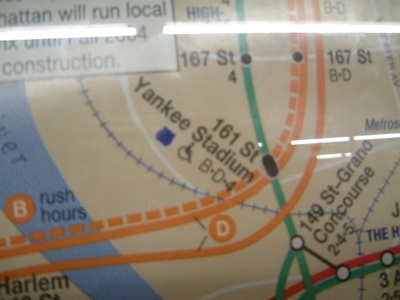
Never drive to Yankee Stadium to see a night game. The cabbie laughed when we asked how long it would take to get to Yankee Stadium from Midtown (-1). He advised us to take the subway (+1). The subway is super-fast in NYC, and it got us from Central Park to the Stadium in a couple of minutes (+1). Not to say the ride was enjoyable, though. The train was packed so tight that you didn't even need to hold on to anything. The smell isn't all that pleasant either, but the trip was short at least. You could also take the Yankee Clipper ferry from New Jersey or the city to get to the Stadium (+1). I'm told it's a nice, albeit expensive, way to get to the game.
Bleacher seats can be bought for around $12 at the Stadium (+1), but you get what you pay for. The bleacher seats are, as can be expected, uncomfortable, and you cannot access the rest of the park if you have bleacher tickets, similar to the situation at Wrigley Field (-1). Yankee Stadium also suffers from the problem with modern stadiums with no support columns in that you can be really far away from the action if you are in the upper decks (-1). The upper deck seats will still run you around $20 (+1). The good stuff is in the lower field boxes, where the seats are padded (+1), but you will have to pay almost $100 to sit in the closest seats, and no less than $50 to sit on the main level (-1). The seats do look comfortable, though, and there are no obstructed view seats at least (+1). There are about 18 different seating prices at Yankee Stadium, which at least gives you a lot of choice, but Yankee tickets are still among the most expensive in baseball (-1).
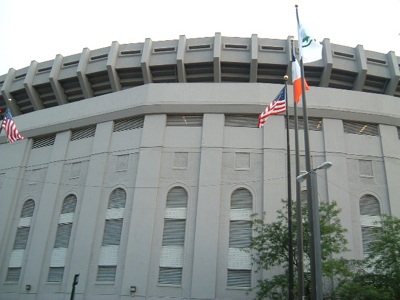
Yankee Stadium's exterior is monumental (+1). The place does look like some sort of fortress from the outside, which isn't a bad thing (+1). I imagine if the Red Sox or Mets tried to attack the stadium it might take them as long as the siege of Kenilworth Castle. The main entrance of the stadium has a gigantic replica of Babe Ruth's bat (+1), and the classic Yankee Stadium name lit up in blue (+1). It is a bit tough to see the full words close-up, but that's only because the place is so massive. You can also see dozens of banners depicting the Yankees' slew of championships. You can already feel the history of Yankee Stadium from the outside (+1).
The classic facade running across the outfield is just beautiful (+1), and it complements the field below where so much history has occurred (+1). The inside of the stadium is just as massive as the outside, which would make sense, and I can honestly say it's a nice looking park, but doesn't really fit into the "classic park" or "modern park" mold. I'm not saying that it's bad that it doesn't fit a mold, but it doesn't really seem to have an architectural identity on the inside. It's almost like the outside of the new Soldier Field that has the classic pillars below a gigantic glass UFO. Monument Park in Yankee Stadium's outfield looks awesome, even though I wasn't able to visit it, and it certainly embodies the spirit of baseball history that pervades the Stadium (+1). You can't visit the park during the game, and we, unfortunately, did not arrive at the game early enough.
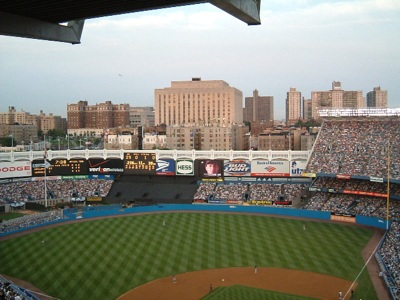
The outfield videoboard, while not as clear as the incredible videoboard at U.S. Cellular Field, is one of the best I've seen (+1), and gives you all the information you could want (+1). The only problem I have with the scoreboard is the fact that the out-of-town scores are shown three-at-a-time, and go by way too fast (-1). I had to stare at the thing for a few minutes trying to catch the score of the Cubs' game. The ads across the outfield wall are reminiscent of the ad boards that were located in most classic baseball parks (+1), and, of course, the classic facade tops off the scoreboard and outfield ads to give it a great look (+1).
There really isn't much for kids to do other than watch the game. There is no playground for the little ones (-1), and they don't even have skill challenges for older kids (-1). The Yankees are also one of the few teams that doesn't let kids run the bases after Sunday home games (-1).
The fans in New York know their baseball (+1). Even though the Yankees got blown out in the game I went to the fans cheered at appropriate times (+1) and were into the game until the end (+1). The fans can tend to be a little less than hospitable to fans of opposing teams, but it is New York so you can't expect them to sweet talk everyone.
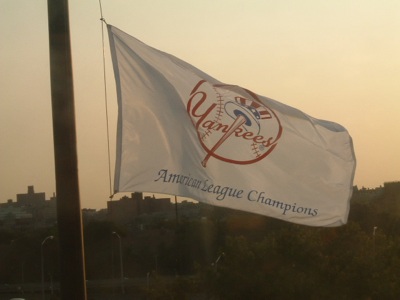
The ushers at Yankee Stadium can at best be described as jerks, and I won't say what they can be described as at their worst (-1). The security is extremely tight at the Stadium, understandable given the situation in New York since 9-11, and there are cops everywhere in addition to the ushers. Don't think you are going to have a chance to get better seats since not only are the lower sections roped off (-1), but many ushers will yell at you just for thinking about moving into a lower section. I was yelled at by an usher for taking a picture of the Yankees' AL Championship flag, and she told me if she saw me using the movie feature of my digital camera she would kick me out so fast my head would spin (-1). It is possible to move up a few rows in the upper deck (+1), but there is just about no chance of moving to a better section at the home of the Yankees, especially if a game is sold out.
"God Bless America" begins the 7th inning stretch at Yankee Stadium (+1), which is especially fitting in New York. After that the real organ (+1) plays "Take Me Out To The Ballgame," which is great seeing that many stadiums now just play recordings of the traditional song (+1). Points off, though, for the stadium tradition of playing "Cotton Eye Joe" after the first two classic baseball songs (-1). I don't know why they play that song as it can't really be a long-standing tradition. Red Nex released the song in 1995, and we've been annoyed by it ever since.
New York is an incredibly dirty city, and the South Bronx that Yankee Stadium resides in is no different (-1). Garbage is everywhere around Yankee Stadium, and on hot summer days, like the day I went to a game, it can just plain smell. There are a lot of nice places around the Stadium such as Billy's Stadium Sports Bar (+1), Stan's Sports Bar (+1), Stan the Man's Baseball Land (+1), and The Yankee Eatery (+1), but most people don't seem to stick around long after games as the South Bronx isn't the best place for casual visitors to hang out (-1). The subway seems to be the preferred destination after a Yankee's game for most people.